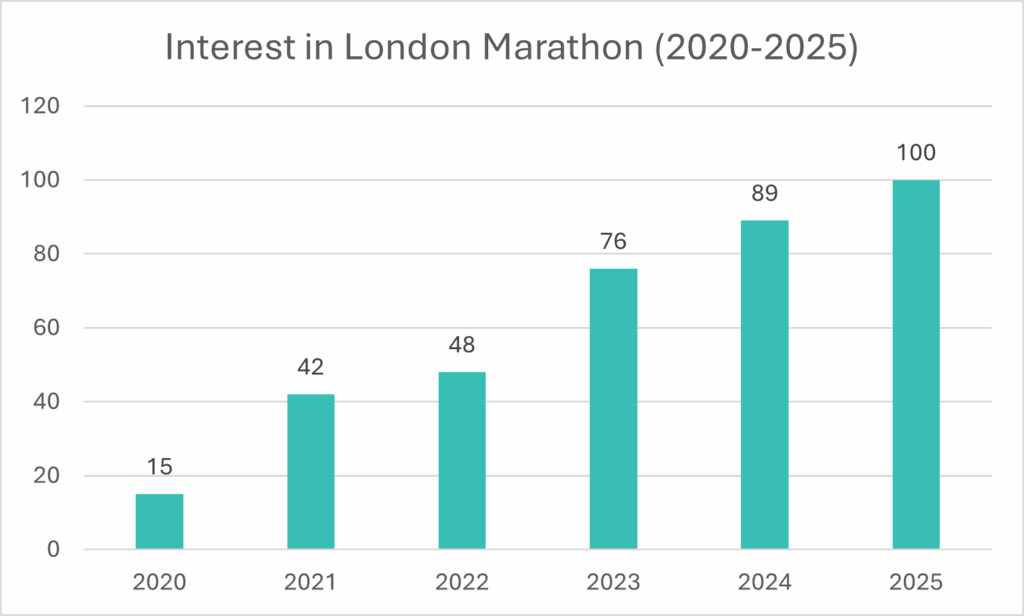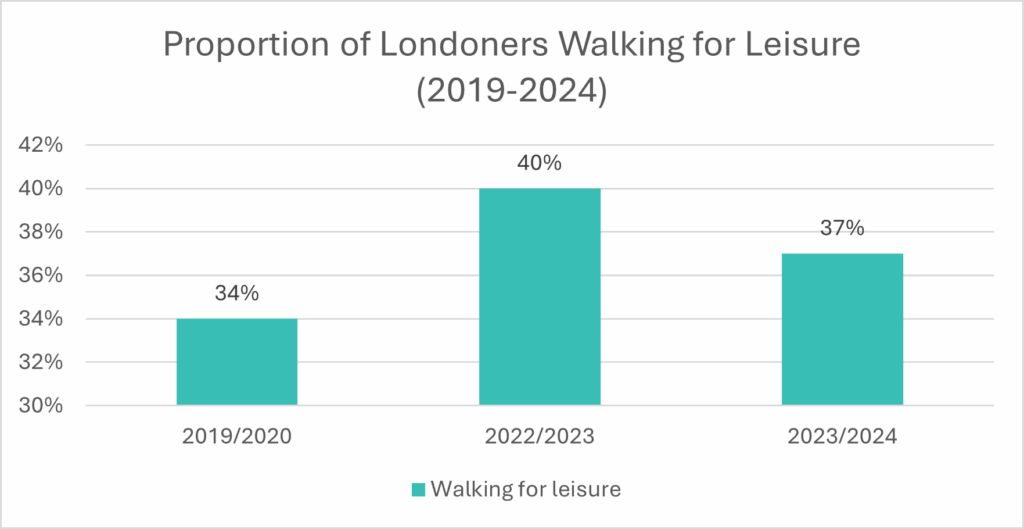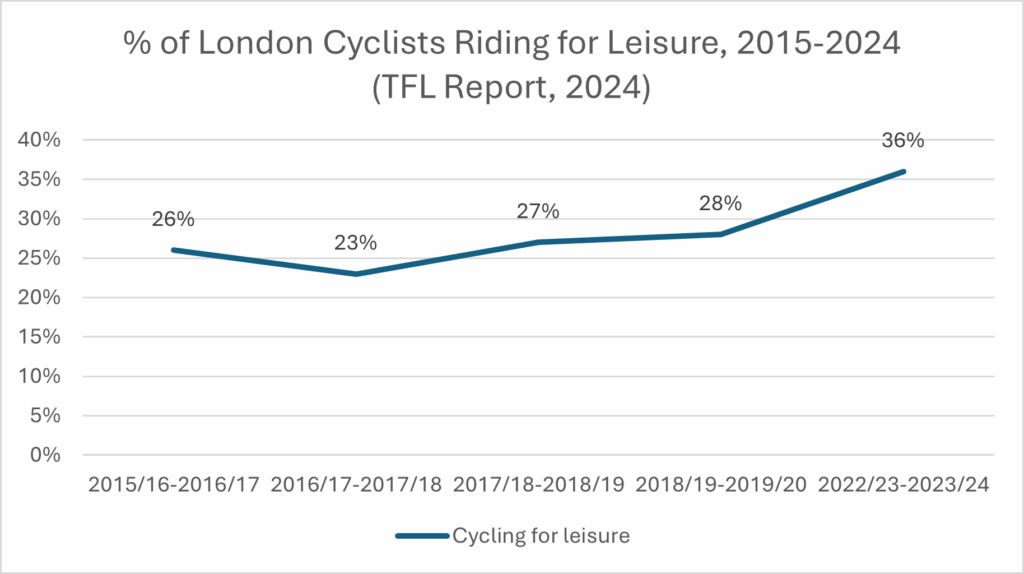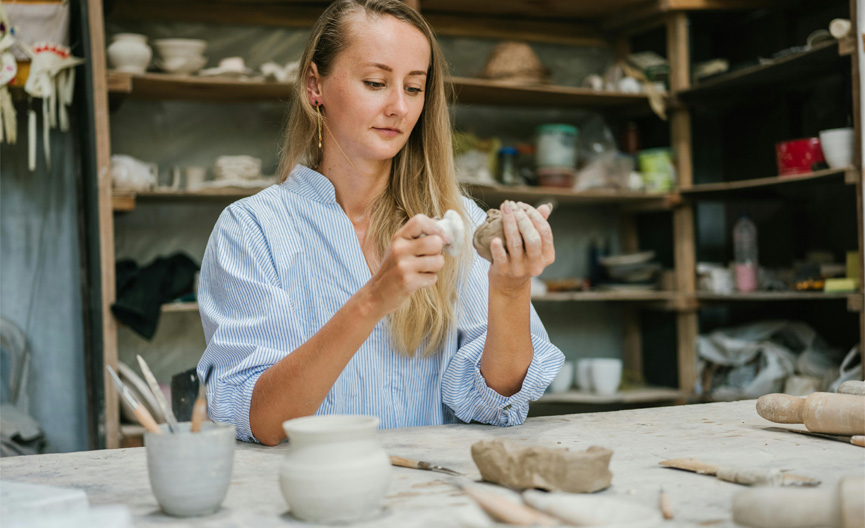According to a 2024 Hornby Hobbies survey, the average Brit now juggles five hobbies – from creative side projects to full-blown social media scroll-athons (yes, that counts now). This growing interest reflects a wider national trend — but how does London compare?
In this report, we explore the most popular hobbies in London, the activities emerging as trends in 2025, and the factors influencing hobby behaviour across the capital.
With 20% of the average Brit’s belongings going unused — and many of us holding on to things purely for sentimental reasons — is our love of hobbies starting to outgrow our homes?
The Most In-Demand Hobbies Amongst Londoners in 2025
In a city as fast-paced as London, hobbies offer a welcome break from the daily rush. They give people a chance to switch off, learn something new, and connect with others. But which pastimes are topping the list for Londoners in 2025?
To find out which classes are most popular amongst Londoners, in August 2025, we analysed Google search volumes in Greater London for 87 hobbies followed by ‘classes near me’ using the tool SEMRush.
| Rank | Type of class | Monthly searches in Greater London |
|---|---|---|
| 1 | Yoga | 3600 |
| 2 | Pilates | 2900 |
| 3 | Zumba | 2400 |
| 4 | Boxing | 1900 |
| 5 | Swimming | 1900 |
| 6 | Pottery | 1600 |
| 7 | Pole dancing | 1300 |
| 8 | Spin | 1000 |
| 9 | Fitness | 1000 |
| 10 | Piano | 1000 |
| 11 | Ballet | 880 |
| 12 | Cooking | 720 |
| 13 | Singing | 720 |
| 14 | Sewing | 720 |
| 15 | Dancing | 590 |
| 16 | Gymnastics | 590 |
| 17 | Acting | 590 |
| 18 | Line dancing | 480 |
| 19 | Martial arts | 480 |
| 20 | Spanish | 480 |
Top 20 Most Searched-For Hobbies in Greater London (August 2025)
- In Greater London, fitness classes lead the way, making up 80% of the top 20 most Googled classes, followed by creative hobbies at 15% and cultural or language pastimes at 5%.
- The most searched class in the region is yoga, with 3.6k monthly searches.
- This is followed by pilates (2.9k), zumba (2.4k), boxing (1.9k) and swimming (1.9k).
- Among searches for creative classes, pottery leads with 1.6k monthly searches in Greater London.
- While piano is the most searched music class, with 1k monthly searches, followed by drums (260) and guitar (210).
- Londoners are also keen to learn Spanish with 480 monthly searches, followed by French (390) and Italian (170).
Please note: we removed team sports from the list.
Which Hobbies Do Londoners Do Most in 2025?

So now we know what hobbies the most in demand classes are in London, but which hobbies do Londoners already do on a regular basis? Our analysis of TGI data from a survey of 25,000 British adults (June 2023–May 2025) found:
- The most popular hobby amongst Londoners is cooking, with nearly half of the city’s population doing this on regular basis (47%).
- Listening to music is the second most popular pastime in London, with over a third saying they do this regularly (33.5%).
- The third most popular hobby amongst Londoners is reading, frequented by over a quarter (25.5%).
- Despite living in the most built-up UK city, many Londoners also enjoy outdoor activities, such as walking, hiking and rambling (18.5%) and gardening (18%).
The table below shows the capital’s 20 most popular hobbies as of 2025:
| Rank | Hobby/Activity | % of Londoners who do this on a regular basis |
|---|---|---|
| 1 | Cooking | 47% |
| 2 | Listening to music | 34% |
| 3 | Reading | 26% |
| 4 | Gardening | 18% |
| 5 | Walking/ Hiking/ Rambling | 18% |
| 6 | Crossword/ Sudoku | 16% |
| 7 | Baking | 14% |
| 8 | Other puzzles & games | 8% |
| 9 | DIY/ Decorating | 7% |
| 10 | Board games | 7% |
| 11 | Photography | 7% |
| 12 | Singing | 8% |
| 13 | Computing | 5% |
| 14 | Bird watching | 5% |
| 15 | Meditation | 6% |
| 16 | Sewing | 6% |
| 17 | Playing a musical instrument | 5% |
| 18 | Knitting | 3% |
| 19 | Other card games i.e. Uno | 4% |
| 20 | Family history/ Genealogy | 5% |
Hobbies More Popular in London That the UK Average
Now we know which hobbies Londoners do the most – but how do they compare to the rest of the UK? Our analysis found:
- Londoners are 48% more likely than the average Brit to play cards such as Poker, with 7.14% playing regularly compared to 4.83% nationwide.
- Around 1 in 15 Londoners take part in creative writing — from novels to poetry — compared to just 1 in 22 nationwide, making it 42% more popular in the capital.
- Amateur dramatics and dance draw 32% more participants in London than elsewhere in Britain, at 2.13% versus 1.61% nationwide.
- Londoners are 20% more likely to code as a hobby than the average Brit, with 2.70% taking part compared to 2.26% across the UK.
Meanwhile, although knitting ranks among London’s top hobbies, it’s less common in the capital, with only 3.12% knitting regularly — 41% fewer than the 5.25% nationwide.
Which Sports Do Londoners Play Most in 2025?

Sport England’s nationwide Active Lives Adult Survey (Nov 2023–Nov 2024) is one of the largest studies of its kind, with responses from 121,926 UK adults. The survey tracks which activities people take part in at least twice within the past 28 days. The data shows that:
- Walking is the most common activity for Londoners, with 58% taking part regularly — making it the city’s top way to stay active.
- Active travel—such as walking or cycling for transport—follows closely, with 46% of residents saying they used it at least twice in the past 28 days.
- Sporting and fitness activities like running, aerobics, or strength training also remain popular, with around 1 in 3 Londoners taking part in each.
- Cycling stands out, with 19% of adults cycling at least twice in the past month—26% higher than the national average of 15.2%.
In terms of sporting and fitness activities, this survey also shows that:
- Tennis is far more popular in London, with 3.1% of residents playing compared to 1.9% across the UK.
- More Londoners hit the gym, with nearly 15% working out regularly versus 13% nationally.
- Londoners are more likely to run or jog than the average Brit, with 16.7% taking part compared to 13.9% nationwide.
- In fact, more than a 1.1 million people have applied to run the 2026 London Marathon — a 31% increase from 2025.
According to Google Trends, interest in the London Marathon has grown by an average of 56% year-on-year over the past five years in the UK.

Londoners take part in active travel around 35% more often than the average Brit and according to the latest TFL report from 2024:
- Walking accounts for 37% of all trips in London, with cycling at 3%, making them the city’s most common commuting methods.
- Over the last three years, walking for leisure has fluctuated, with a noticeable decrease from 40% in 2023 to 37% in 2024.

- Among London cyclists surveyed between 2022 and 2024, 36% reported that their primary purpose for cycling was leisure.
- Cycling for leisure has grown steadily, rising by nearly 10% on average each year between 2015 and 2024.

With more Londoners running, cycling and training, sports gear is piling up in already small homes – making storage for sport equipment an increasingly common way to keep things manageable.
What is influencing leisure activity in London?
Whether it’s rising cost of living or lack of space, Londoners face a variety of factors that affect the way they engage with leisure. We analysed the latest surveys and studies to uncover the common factors shaping hobbies in the capital in 2025.
According to a 2024 Ipsos survey:
- 36% of Londoners say their home is too small and 33% are unhappy with their living conditions.
- On average, the City of London have the smallest homes in the country with a typical floor space of just 47 m² (KCL/UCL Housing Study, 2023).
It may also be the case that Londoners have limited disposable income for hobbies and leisure activities.
- Londoners spend nearly half (42%) of their income on rent or mortgage payments.
- According to a 2024 Sport England report, 13% of Londoners have cancelled sport of club memberships compared with only 7% across the rest of the UK.
In addition, Londoners also have less time. Recent data reveals that:
- While the average Brit spends around 30 minutes a day travelling, Londoners face nearly double that, averaging around 54 minutes commuting in 2023/24.
- Based on an 888 casino study, Londoners get just 37 minutes of “me time” each day, compared with 46 minutes for the average UK adult.
For many, small living spaces make it harder to enjoy hobbies that require bulky gear – from bikes to guitars. Storage offers a practical way to keep equipment safe, while also making it easier to rotate what you need so you can free up room at home.
How much waste do London hobbies generate?
Most hobbies—whether it’s painting, sewing, gardening, model-making, baking, or electronics—create waste in the form of packaging, material offcuts, and sometimes even hazardous residues. The latest statistics on waste generated in London shows that:
Cooking as a top hobby adds to food and packaging waste.
- Food waste is the largest part of household waste in London, making up 27% of the total. Almost a fifth (19%) of this is still edible — a notable figure given that cooking is the city’s most popular hobby in 2025.
- Cooking as a pastime can also contribute indirectly to packaging waste, as ingredients often come wrapped in plastic, paper, or other materials.
- Paper and cardboard make up around 21% of household waste by weight, with plastic at 11% and glass at 10%.
- Altogether, London produces around 2.2 million tonnes of packaging each year, generating 4.1 million tonnes of CO₂e, with plastic alone responsible for nearly 1.9 million tonnes CO₂e.
Playing instruments, photography, and computing are among London’s popular hobbies, and many rely on devices that add to e-waste.
- In 2023, Londoners discarded £1.9 billion worth of repairable items — over £250 per adult.
- ReLondon survey data (2024) shows that 75% of electronics (e.g., cameras, musical equipment) are considered for repair, compared with 61% of electricals (e.g., glue guns, pottery wheels), suggesting some hobbies items are discarded sooner than others.
Meanwhile, London’s high engagement in creative hobbies such as sewing and knitting highlights the potential for reducing textile waste:
- Only 10% of worn clothing collected in London is reused locally, with the rest thrown away — a missed opportunity to turn unwanted fabric into something useful.
- A ReLondon study (2023) found that cutting new clothing purchases by 30% — by replacing 25% with second-hand items and repairing 5% of garments — could reduce fashion-related emissions in London by 30%.
Hobbies & Leisure Statistics on 2025
We hope this report has helped shine a light on how Londoners are spending their free time — and the challenges that come with limited space, rising costs, and hobby-related clutter. If you’re looking for practical ways to create more room for the things you enjoy, Attic Self Storage offers flexible options across London.
From long-term storage for treasured items to short-term solutions for rotating seasonal gear and craft projects, we make it easy to free up space and enjoy your hobbies. You can also explore our helpful guides on decluttering and creating more room at home.



